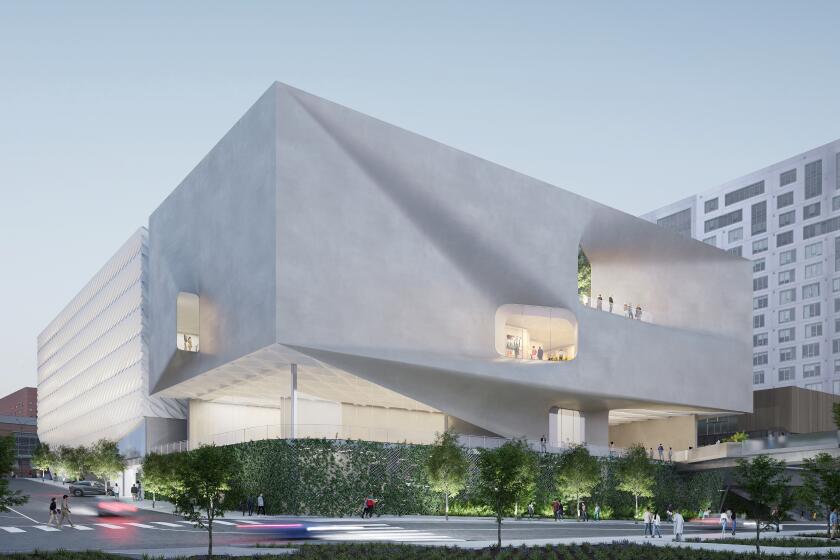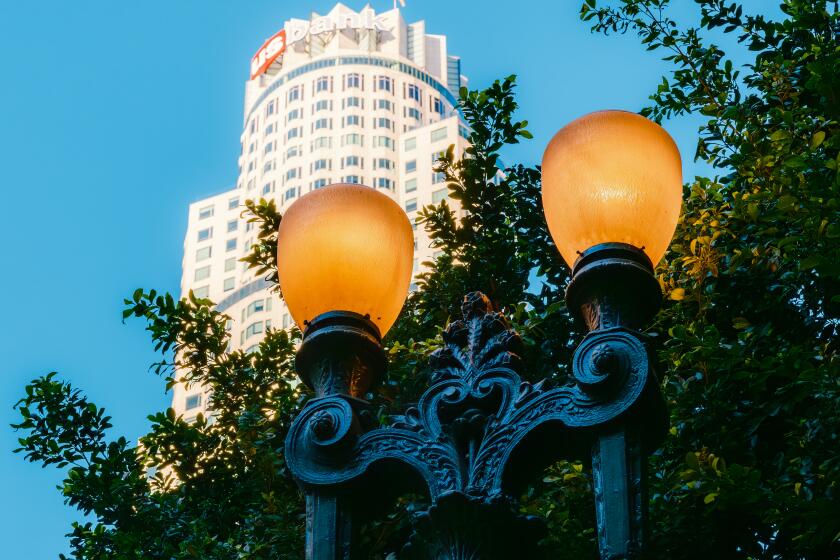Turn signals on Grand
Much has been said about the Frank Gehry-designed Grand Avenue project, from jaded urban commentators bemoaning the project’s lack of progress on the ground and taxpayer subsidies to starry-eyed downtown boosters -- myself included, at times -- who see the giant development as a validation of the urban Angeleno lifestyle.
But with government officials overseeing the project growing increasingly concerned about the repeated delays in the beginning of construction, now expected to get underway in February, it’s time to ask a larger question: Have we become too locked into one vision of this development? If cost estimates keep going up and construction is delayed again and again, shouldn’t we think about backing out of part of the project in favor of some other vision?
A world-class development across the street from the iconic Walt Disney Concert Hall -- itself once plagued with cost overruns and construction delays -- and near the Music Center has been the dream of local politicians for years. There’s no question that transforming a makeshift parking lot used mostly by reluctant jurors into a five-star hotel adjacent to two residential towers and an upscale shopping center would further shake the stigma of downtown as a place plagued by homelessness and blight.
The Grand Avenue project would offer other benefits as well. It would bring in much-needed tax revenue by creating living-wage jobs and stimulating retail sales downtown. And its developer, Related Cos., will finance the construction of a civic park linking City Hall and the Music Center.
But in Los Angeles, our politicians often get swept up in overly grand visions, including the leveling of Victorian homes on Bunker Hill to make way for office towers and the unfunded Los Angeles State Historic Park -- known as the “cornfield” -- north of Union Station. Mega-projects such as Grand Avenue may keep the city in the pages of architectural publications, but too often, the economic reality of them yanks our collective heads out of the clouds.
Take, for example, the unrelenting rise in the cost of construction. Because the building and infrastructure boom in China is increasing demand for steel, glass, concrete and other materials, the cost of constructing skyscrapers worldwide has soared. Cost estimates of the Grand Avenue project have increased by nearly $1 billion since planning began in 2003. The three-phased project is now projected to cost just shy of $3 billion.
The already high price tag means that Related Cos. isn’t able to build the three phases concurrently and will most likely seek construction delays on the subsequent phases. On the current timeline, the second phase of the project won’t be completed until the middle of the next decade -- and that’s only in the unlikely case that there are no more delays.
Meanwhile, the cost of raw materials will continue to rise, and confused tourists will continue to ask why our prized architectural jewel -- Disney Hall -- still overlooks a parking lot.
So what’s the solution?
The joint powers authority charged with directing the course of the development should do the unthinkable: Take a step back from the grand vision and allow the free market to take over by selling the development rights on the four remaining Grand Avenue parcels to different developers. Once the economy improves, the individual projects would be in a stronger position to secure financing than one mega-development.
To acknowledge the great work that has been done so far by Related Cos. and Gehry Partners, the project’s first phase should be allowed to proceed as planned, even with all the delays. We’ve come too far to go back to the drawing board now.
But great cities and neighborhoods are rarely created by a single developer. Different buildings, each contributing in its own way to the feel of a street or neighborhood, can become a powerful visual symbol of Los Angeles. Letting market forces decide what is feasible for the Grand Avenue project would help ensure that everyone gets what they want: an exciting gathering place for L.A. in the shortest time possible, with minimal taxpayer subsidies.
Of course, building-permit approvals would have to be streamlined and design standards set to ensure high-quality projects with fewer construction delays. Developing the remaining Grand Avenue parcels as quickly as possible with projects that the market can bear should be the priority.
Proceeds from remaining leases should be used to build a downtown streetcar system that could shuttle Angelenos from one mega-development to the next in modern, Portland-style trolleys.
The Grand Avenue project is important to the future of downtown not only as a revenue generator but as a symbol of the many strides made in the city’s center. Letting market forces shape it may be the best way to get what we need faster.
More to Read
The biggest entertainment stories
Get our big stories about Hollywood, film, television, music, arts, culture and more right in your inbox as soon as they publish.
You may occasionally receive promotional content from the Los Angeles Times.






